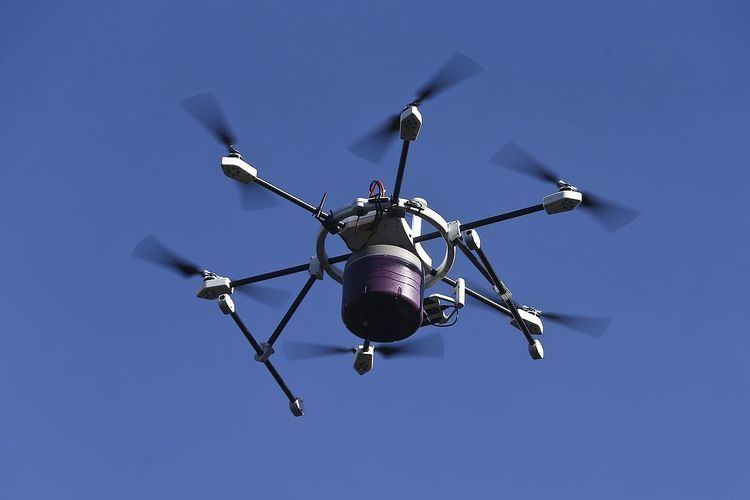 | ||
A delivery drone, is an unmanned aerial vehicle (UAV) utilized to transport packages, food or other goods.
Contents
Legislation
In the United States initial attempts at commercial use of UAVs, such as the Tacocopter company for food delivery, were blocked by FAA regulation. As of 2015, delivering of packages with drones in the United States is not permitted. On the 13th March 2015, in Sheffield, FPS Distribution completed the first commercial delivery using a UAV.
In healthcare
UAVs can transport medicines and vaccines, and retrieve medical samples, into and out of remote or otherwise inaccessible regions. "Ambulance drones" rapidly deliver defibrillators in the crucial few minutes after cardiac arrests, and include livestream communication capability allowing paramedics to remotely observe and instruct on-scene individuals in how to use the defibrillators.
In July 2015, the FAA approved the first such use of a drone within the United States, to deliver medicine to a rural Virginia medical clinic in a program called "Let's Fly Wisely."
Drug smuggling
Drug cartels have used UAVs to transport contraband, sometimes using GPS-guided UAVs.
Prison smuggling
From 2013 and 2015, UAVs were observed delivering items into prisons on at least four occasions in the United States while four separate but similar incidents occurred in Ireland, Britain, Australia and Canada as well. Though not a popular way of smuggling items into prisons, corrections officials state that some individuals are beginning to experiment with UAVs.
In November 2013, four people in Morgan, Georgia were arrested for allegedly attempting to smuggle contraband into Calhoun State Prison with a six-rotor remote controlled helicopter. The suspects were found with "probably about one or two pounds of tobacco rolled up".
In 2014 a quadcopter crashed into an exercise yard of Wheatfield Prison, Dublin. The quadcopter collided with wires designed to prevent helicopters landing to aid escapes, causing it to crash. A package containing drugs hung from the quadcopter and was seized by prisoners before prison staff could get to it. The damaged quadcopter was handed over to an Garda Síochána.
Between 2014 and 2015, at two prisons in South Carolina, items such as drugs and cell phones were flown into the area by UAVs with authorities and one prison not knowing how many deliveries were successful before gaining the attention of authorities.
Food
Connect Robotics, in a pilot project with Santa Casa da Misericórdia de Penela and Penela Town Hall, made a first meal delivery per drone in December 2016. The project intends to be an alternative to the transport done with the mini-van. The first beneficiary to take advantage of this delivery service was Joaquim dos Reis, a septuagenarian living in Podentinhos, who, in addition to meals delivered by the drone, continue to receive the home assistance provided by Santa Casa.
The Tacocopter is a taco delivery concept utilizing a smartphone app to order drone-delivered tacos in San Francisco area. It was created by MIT graduate Star Simpson and its website went live in July 2011, garnering the public and the media attention. The revelation that it didn't exist as a delivery system or app led to it being labelled a hoax.
An independent British franchise of Domino's Pizza tested a remote-controlled drone, called DomiCopter, to deliver pizzas. It was developed by a joint effort of U.K. drone specialist AeroSight, Big Communications and creative agency T + Biscuits. A short footage video was released in June 2013.
A German-based restaurant on Anna Maria Island, Florida is testing a remote-controlled drone delivery service. The delivery is called Old Hamburg Schnitzelhaus AIR, to deliver Schnitzel#Wiener Schnitzel to the nearby beach. It is currently pending regulatory approval. It was developed inhouse with DJI drone parts. A footage video was released in November 2015.
Burrito-by-drone deliveries to be tested at the Virginia Tech campus by Chipotle and Google as per articles from September 2016. This is not the first time the concept has come up. There used to be the "burrito bomber" in 2012.
Postal Deliveries
With the rapid demise of snail mail and the explosive double digit growth of e-Commerce, postal companies have been forced to seek new ways to yond their traditional letter delivery business models. Different postal companies from Australia, Switzerland, Germany, Singapore and Ukraine have undertaken various drone trials as they test the feasibility and profitability of unmanned delivery drone services.
